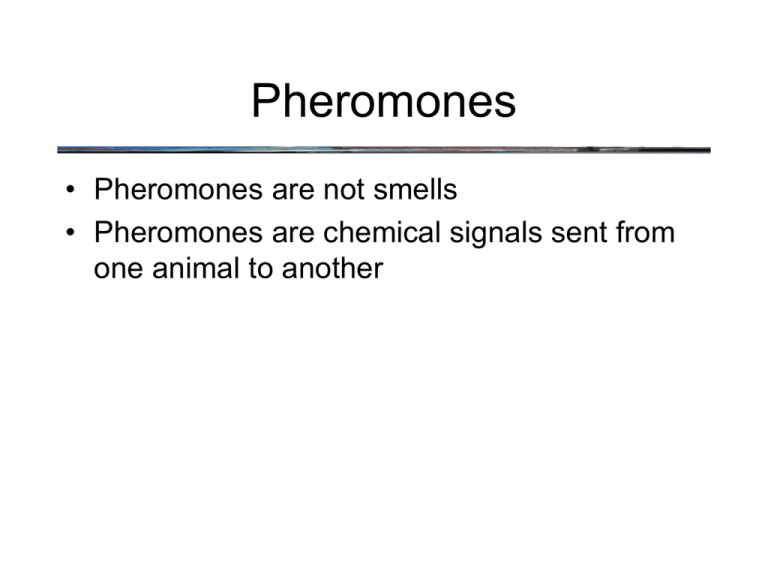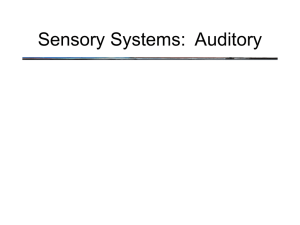Pheromones • Pheromones are not smells one animal to another
advertisement

Pheromones • Pheromones are not smells • Pheromones are chemical signals sent from one animal to another Pheromones • Pheromones either induce a behavior in another animal or cause some physiological change • Very common in insects...not so common in mammals...unclear role in humans Fun Facts about Pheromones • For example: Androstenone, found in male pig saliva, causes a female pig to allow the male to mate with her Fun Facts about Pheromones • androstenone is also found in the sweat of human males! • Does androstenone (or pheromones in general) affect humans? • Design an (ethical) experiment… Fun Facts about Pheromones • Kirk-Smith & Booth (1980) sprayed some of the seats in a dentist’s waiting room with androstenone • Compared to a control condition, more women used the androstenone seat Fun Facts about Pheromones • Fewer men used the androstenone seat ! Pheromones • Other possible ways in which pheromones influence humans: – synchronization of menstrual cycles – mate selection - attraction to opposite major histocompatibility complex Pheromones • Pheromones do not control behavior! • Human behavior is largely under top-down influences, but may be affected subtly by pheromones • It is unclear whether molecules such as androstenone even qualify as pheromones they may be just like other odour molecules Sensory Systems: Auditory What do we hear? • Sound is a compression wave: Speaker Air Molecules When speaker is stationary, the air is uniformly dense What do we hear? • Sound is a compression wave: Speaker When the speaker moves, it compresses the air in front of it. What do we hear? • Sound is a compression wave: Rarefaction Compression The speaker moves back leaving an area with less air behind called rarefaction What do we hear? • Sound is a compression wave: Speaker Compression Rarefaction The speaker moves forward again starting the next wave What do we hear? • Sound is a compression wave - it only “looks” like a wave if we plot air pressure against time Period - amount of time for one cycle Frequency = number of cycles per second (1/Period) Air Pressure time -> Properties of a Sound Wave • 1. Amplitude: difference in air pressure between compression and rarefaction (Sound Pressure Level) Properties of a Sound Wave • 1. Amplitude: difference in air pressure between compression and rarefaction (Sound Pressure Level) – What is the perception that goes along with the sensation of sound amplitude? Properties of a Sound Wave • 1. Amplitude: difference in air pressure between compression and rarefaction (Sound Pressure Level) – What is the perception that goes along with the sensation of sound amplitude? LOUDNESS Properties of a Sound Wave • 2. Frequency: how many regions of compression (or rarefaction) pass by a given point per second (expressed in Hertz) Properties of a Sound Wave • 2. Frequency: how many regions of compression (or rarefaction) pass by a given point per second (expressed in Hertz) – What is the perception that goes along with the sensation of frequency? Properties of a Sound Wave • 2. Frequency: how many regions of compression (or rarefaction) pass by a given point per second (expressed in Hertz) – What is the perception that goes along with the sensation of frequency? PITCH Sensing Vibrations Sensing Vibrations • Outer ear transmits and modifies sound (critical for sound localization) Sensing Vibrations • Middle ear turns compression waves into mechanical motion oval window stapes Sensing Vibrations • Middle ear turns compression waves into mechanical motion Oval window Ear Drum Sensing Vibrations • Middle ear turns compression waves into mechanical motion Oval window Ear Drum Compression Wave Sensing Vibrations • The cochlea, in the inner ear, is a curled up tube filled with fluid. Auditory Nerve to Brain Sensing Vibrations • Inside the cochlea is the basilar membrane • Movement of the oval window causes ripples on the basilar membrane Sensing Vibrations • Basilar membrane measures the amplitude and frequency of sound waves – amplitude (loudness) –frequency (pitch) Sensing Vibrations • Basilar membrane measures the amplitude and frequency of sound waves – amplitude (loudness) - magnitude of displacement of the basilar membrane –frequency (pitch) Sensing Vibrations • Basilar membrane measures the amplitude and frequency of sound waves – amplitude (loudness) - magnitude of displacement of the basilar membrane –frequency (pitch) - frequency and location of displacements of the basilar membrane Sensing Vibrations • Basilar membrane measures the amplitude and frequency of sound waves –frequency (pitch) - frequency and location of displacements of the basilar membrane







